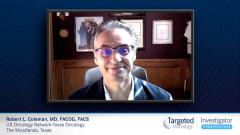
Systemic Therapy for Advanced Endometrial Carcinoma
The rationale for using systemic therapy to treat patients with advanced endometrial cancer.
Episodes in this series

Robert L. Coleman, MD, FACOG, FACS: While this patient had a lot of very favorable prognostic features and we hoped she would have been cured with her surgery and adjuvant local brachytherapy, she had a recurrence in a relatively short period, just 14 months after completing her therapy. In this particular situation, we have a number of options. Most of the time, the presence of metastatic disease wants us to pursue the use of chemotherapy because it’s systemically administered, and we have studied chemotherapy in this disease for decades. Paclitaxel-carboplatin is where we are right now as a backbone.
There are cases in which we might consider some alternatives, though. I’ve seen several patients like this case who present with ER [estrogen receptor]-positive, progesterone receptor-positive endometrial cancer who have low-grade tumors and may be a candidate for hormonal therapy. We’ve studied hormonal therapy mostly in the metastatic recurrent setting, but we have data for the use of hormones for endocrine-based therapy, or endocrine-based therapy with other targeted therapy, such as a PI3 kinase pathway inhibitor or mTOR inhibitors, where we might be able to offer an alternative for patients who may be at high risk of chemotherapy complications or who decline chemotherapy. But in general, chemotherapy, paclitaxel-carboplatin, is the backbone by which we have based most of our treatment algorithm pathways for patients with metastatic recurrent disease.
The treatment options for patients who have MSI [microsatellite instability]-high tumors or deficient MMR [mismatch repair] has worked an algorithm through that has demonstrated that pembrolizumab as a single agent has activity. This led to an accelerated approval for that compound 4 years ago.
As we’ve looked at the treatment landscape for patients who have tumors that are microsatellite-instable or deficient MMR, the use of immunotherapy, such as pembrolizumab and dostarlimab, have demonstrated their efficacy as single agents in that setting. But for the vast majority of the patients who have proficient MMR tumors, or who are microsatellite-stable, we have focused on the use of chemotherapy. However, there’s been interest in patients who have previously progressed on chemotherapy for the combination of 2 drugs, one of which I just mentioned and a second drug, a multitargeted tyrosine kinase inhibitor called lenvatinib, which has single-agent activity in patients who have recurrent endometrial cancer.
We were very excited to see those very early preliminary data in patients who have proficient tumors, given the response of this particular combination. The first study to demonstrate that efficacy was KEYNOTE-146, which looked at the combination of lenvatinib and pembrolizumab in women who had recurrent and measurable endometrial cancer. What was exciting about this particular trial is that we had seen a response rate of about 40% in this population. This wasn’t broken down specifically by limiting eligibility to whether you’re MSI-high or PD-L1 status, but we saw activity across the spectrum. But what was most notable and interesting for most of us was that we saw activity in patients who had microsatellite-stable tumors. That response rate was very encouraging and was the foundation for the conduct of KEYNOTE-775.
Based on the KEYNOTE-146 data, it became important to assess how active it is. We knew it was active, but how active was it relative to what would be considered standard of care chemotherapy? KEYNOTE-775 was conducted to directly address that question. It was a large trial that was made up of both proficient and deficient MMR tumors. These patients were given the combination with respect to what was considered physician choice chemotherapy in this setting. The 2 active agents in this setting would have been paclitaxel or doxorubicin, and both were allowed as physician choice alternatives for the standard of care arm.
This trial was randomized 1:1 and basically confirmed what we had already seen and our suspicions that this was an active regimen. This particular trial was very well done, well conducted, and very thoughtful with respect to its end points. It demonstrated efficacy from the point of view of progression-free survival, essentially almost doubling it, with hazard ratios of 0.55 to 0.6 across the different subgroups that were evaluated. But for the all-comer population—anybody walking in the door who essentially met the eligibility criteria—there was a profound effect, with a hazard ratio of 0.56. This also amounted to an improvement in overall survival with almost the same hazard ratio of 0.62. These 2 factors landed this particular initial accelerated approval into a regular approval, which was granted on July 21, 2021. We’re very excited to have this combination available for our patients, but it begs the question, how far can we take it?
Transcript edited for clarity.
Initial Presentation
- A 64-year-old postmenopausal woman presented with abnormal uterine bleeding for about 2 months. She has two grown children, underwent menopause at 57 years of age, has no known family history of cancer.
- PMH: BMI is 32, and she has hypertension that is controlled with medication
- PE: Notable for large uterus and right lower quadrant abdominal tenderness on palpation
Clinical work-up
- Endometrial biopsy: endometrioid adenocarcinoma, FIGO grade 1
- Surgery: ELAP TAH BSO with bilateral pelvic node dissection
- Pathology: grade 2 endometrioid adenocarcinoma, 18 negative pelvic nodes, invasive 2.1 cm of 2.3 cm myometrium
- Molecular testing shows MSS, MMR proficient, and HER2-
Treatment
- Postoperative radiotherapy: vaginal cuff brachytherapy to a dose of 21 Gy in 3 fractions
- 14 months after completing radiotherapy, she presented with new RLE edema and right hydroureter
- She then was treated with carboplatin/paclitaxel chemotherapy which was well tolerated
- Nine months later the patient has disease relapse with metastases to the paraaortic lymph nodes and lung
- She is now treated with lenvatinib/pembrolizumab






































